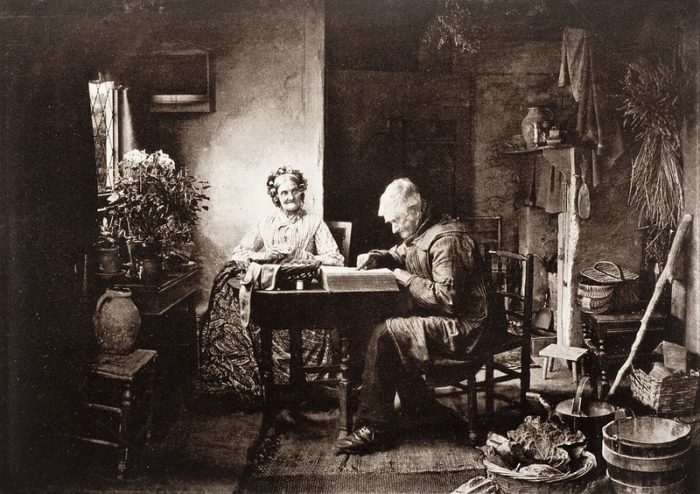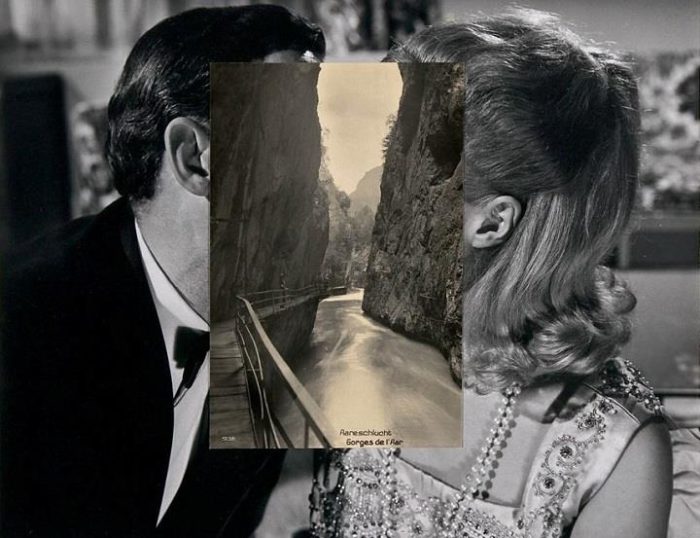In the simplest terms, photomontage is the process of combining or layering photographs together to express more about the subject than what can be shown by a single image. The artwork was initially created by cutting, gluing, and arranging photographs and prints, sometimes combined with text or abstract shapes. With the advent of digital photography and editing software, the need for physical protographs we no longer required for these re-interpretations. The art of photomontage provides the opportunity to work with photographs in ways other than their original intent. Instead of a clear and accurate representation of reality, it aims to combine concepts, giving them meaning beyond their original scope.

Some of the earliest photomontage pieces came from the Victorian era, first by expert photographer Oscar Gustave Rejlander and then by artist Henry Peach Robinson. In 1857, Oscar Rejlander created the piece Two Ways of Life. Using a technique known as combination printing, he photographed each model and background separately before meticulously combining them into a single print. Although he did not create combination printing, Two Ways of Life was the most complex and elaborate example of the technique to date. The following year, prominent art photographer Henry Peach Robinson created his piece Fading Away, his most famous work. These early photocollage works depicted classic Victorian themes such as morality, religion, and beauty in death.

In the 20th century, the technique gained momentum, flourishing in Europe by the start of World War I. The radical, nihilist political fringe inspired musicians, writers, and artists to create an altered view of reality. This period saw the birth of conceptual and kinetic art. It ushered in an era of irrationality and avant-garde approaches in response to what many perceived as a senseless war. German expatriates Hugo Ball, a writer, and Richard Huelsenbeck, an artist, named this artistic movement Dada. Ball picked the word ‘dada’ from a French-German dictionary as it embodied the absurdity of the movement it aimed to describe. “Dada is ‘yes, yes’ in Rumanian, ‘rocking horse’ and ‘hobby horse’ in French,” he noted in his diary. “For Germans, it is a sign of foolish naiveté, joy in procreation, and preoccupation with the baby carriage.” Tzara, who later claimed that he had coined the term, quickly used it on posters, put out the first Dada journal, and wrote one of the first of many Dada manifestoes, few of which, appropriately enough, made much sense. (Trachtman)” It was Dadaism that developed photomontage as a protest tool, cementing its place as a genuine modern art form.
“The vast variety of styles and ways of working helped them depict awakening pictures of reality and drew attention to the eerie consequesnces of our own doing.”
Nadia Herzog, Elena Martinique, & Angie Kordic for Widewalls
The Berlin-based Dadaists used the medium to proliferate anti-war imagery. They repurposed mass media imagery and used photographs and reproductions in their pieces, emphasizing the destructive nature of war. These pieces were constructed using scissors and glue rather than the Victorian method of combination printing. This technique enabled artists to utilize various media in their designs, allowing them to communicate their critique of world events with a sharper tongue. “The vast variety of styles and ways of working helped them depict awakening pictures of reality and drew attention to the eerie consequences of our own doing, while at the same time these attacked the notions and imposed rules of traditional art-making. (Kordic)” The works of anti-Nazi activist John Heartfield, as well as those by Kurt Schwitters and Johannes Baader, contributed to the development of the Surrealist movement later in the 20th century. Surrealist artists Salvadore Dalí and Man Ray were both prominent practitioners of photomontage as an artistic medium.

Photomontage techniques have evolved considerably over time as technology becomes more sophisticated. Victorian era combination printing eventually gave way to the front-mounted projection method used by Romare Bearden in the late 1800s. This technique involved hand mounting paper, paint, and photographs onto boards and later photographing them. As mentioned above, Dadaists relied on scissors and glue and took a multimedia approach. Later in the 20th century, advances in analog cameras made using multiple exposures popular among photographers and artists. The advent of digital photo editing software has allowed artists to push the boundaries of photo manipulation. Programs such as Adobe Photoshop, Paint Shop Pro, and Corel Photopaint have simplified the process and opened the doors to a broader range of creative options.

Photomontage artwork is still a popular contemporary medium. British conceptual artist John Stezaker (b. 1949) creates surreal, irreverent collages using appropriated mid-century images such as postcards, film stills, and publicity shots. In a 1991 exhibit at the Salama-Caro Gallery in London, one piece depicts a punch clock with the caption, “Why Spend Time on an Exhibition Like This?” Similarly, feminist graphic artist Barbara Kruger created iconic political pieces with found imagery overlaid with bold text. Both artists used the medium to challenge political and social norms. London-based artist Steve Reynolds creates analog and digital collage art with themes centering on mortality and mental health. In a 2019 interview discussing the elements of his artwork, Reynolds comments, “I tend to take images of the physical human form, deconstruct it in different ways and juxtapose the pieces with elements of abstraction and symbolism.” Contemporary collage artists continue working with themes such as current events, social constructs, and politics to create a visual language that encourages viewers to re-examine the world around them.
Resources:
“Interview: Wolves of Surburbia.” Toombes, 27 March, 2019, https://www.toombes.com/2019/03/27/interview-wolves-of-suburbia/
Trachtman, Paul. “A Brief History of Dada,” Smithsonian Magazine, 1 May, 2006, https://www.smithsonianmag.com/arts-culture/dada-115169154/
Kordic, Angie et. al. “What is Photomontage- The Definition and History,” Widewalls, 1 August, 2016, https://www.widewalls.ch/magazine/photomontage-art
Photo Credits:
“John Stezaker, Disjointed Harmony by bianca.maggio is marked with Public Domain Mark 1.0
